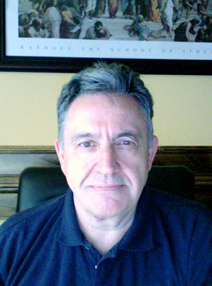 A man of diverse interests and avid curiosity, Raúl A. Baragiola, the Alice and Guy Wilson Chair Professor of Materials Science at the University of Virginia, passed away 21 June 2015, only few months after his seventieth birthday. Raúl began his career at the Balseiro Institute in Bariloche, Argentina, studying electron emission from solid materials, later expanding his expertise to ion, electron, and photon interactions with surfaces. His interest in the surface properties of semi-conductors and insulators led him to the field of Space and Planetary Science, where for the last 25 years he studied the interaction of radiation with condensed ices, minerals, and extraterrestrial materials.
A man of diverse interests and avid curiosity, Raúl A. Baragiola, the Alice and Guy Wilson Chair Professor of Materials Science at the University of Virginia, passed away 21 June 2015, only few months after his seventieth birthday. Raúl began his career at the Balseiro Institute in Bariloche, Argentina, studying electron emission from solid materials, later expanding his expertise to ion, electron, and photon interactions with surfaces. His interest in the surface properties of semi-conductors and insulators led him to the field of Space and Planetary Science, where for the last 25 years he studied the interaction of radiation with condensed ices, minerals, and extraterrestrial materials.
Born 31 March, 1945, Raul came to the US after working many years at the Centro Atómico in Bariloche, Argentina when concerns about the Argentina’s political stability and the safety of his family lead him to emigrate. He joined Ted Madey’s laboratory at Rutgers in 1988. He settled permanently at the University of Virginia (UVa) to direct the Laboratory for Astrophysics and Surface Physics (LASP) in 1990.
At UVa, Raúl started working on electronic sputtering from condensed gases and water ice in close collaboration with R. E. Johnson (UVa) and Walter Brown (AT & T Bell Laboratory), but he soon initiated key experiments designed to explore the complexities of sputtering of water ice. He had notable success in studying water ice photodesorption induced by Lyman-alpha light and its implications for interstellar ices. Subsequent efforts in a similar vein included investigating the existence of condensed O2 on Ganymede, measuring the sputtering yield of various ices, and characterizing the physical and chemical effects of radiations on laboratory analogs of planetary ices, while making laboratory data available to guide interpretation of astronomical spectra. In collaboration with R. W. Carlson (JPL), results from ion irradiation of water ice were used to explain the infrared signature of hydrogen peroxide on the surface of Europa. Raúl made numerous other significant research contributions towards understanding of the properties of planetary and interstellar water ice and the effects of radiation on these extraterrestrial surfaces. Recent ongoing research centered on laboratory astrochemistry, focusing on the synthesis, destruction and sputtering of plethora of condensed ices which include H2, CO, CO2, CH4, NH3, O2, O3, H2O2 and more complex species by ion and UV irradiation.
In collaboration with Lucy McFadden (NASA-Goddard) to understand the sulfur deficit on the surface of the Eros during NEAR’s encounter, Raul initiated research focused on the effects of space weathering on airless bodies. The combined in situ ability to measure reflectance, surface chemistry, and sputtered species due to solar-wind type ion irradiation was a hallmark feature of Raúl’s laboratory. In particular, Raúl was interested in the formation of Fe nano-particles and the effects of Earth’s atmosphere on ion bombarded silicates and minerals. With the discovery of water on the lunar surface, Raúl investigated formation for -OH species by solar wind proton irradiation of silicate minerals. Recent experiments characterizing electron emission from lunar soils echoed his early work on electron-induced secondary electron measurements.
Raúl was a prominent member in the Planetary Science and the Laboratory Astrophysics community and a frequent, vocal participant at DPS, AGU, and LPSC conferences. He was a Fellow of the American Physical Society (APS) and the Institute of Physics (London), receiving a Lifetime Achievement Award from the International Committee on Atomic Collisions in Solids and a NASA Achievement Award for his work on the Cassini mission. He served as a science member on the Cassini Plasma Spectrometer (CAPS) team, collaborating with D. T. Young at Southwest Research Institute (SwRI). Over the course of his career, Raúl published ~ 200 refereed scientific articles and book chapters, contributed to more than 140 conferences presentations and 80 invited lectures, advised more than 40 students and post-doctoral researchers on multiple continents, and collaborated with more research groups than is possible to name. His scientific legacy endures through them.
He leaves behind his dear wife of 46 years, Beatriz; three children: Verena, Valeria, and Pablo; his three precious grandchildren: Maya, Ella, and Leo who were the pride and joy of his later life; and his family of students and post-docs. All of whom will greatly miss Raul’s ability to simplify deeply complex problems, as well as his passion for life, philosophy, and wicked sense of humor.
————————————-
Catherine Dukes – Research Scientist – Laboratory for Astrophysics and Surface Physics – UVa
Ujjwal Raut – Research Scientist – Laboratory for Astrophysics and Surface Physics – UVa
